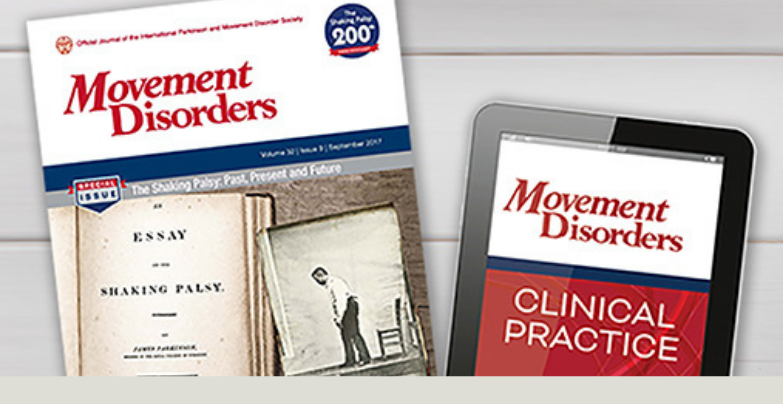
Courses
Advance your knowledge in engaging, interactive courses developed and taught by leaders in the field.
Course Types
Browse All MDS Courses
New courses are added regularly.
Sign up for email notifications »
Results Updated, 10 Results.
Skip to FiltersMDS Curriculum Track: Parkinson's Disease - Advances in Pathology, Genetics, Biomarkers, and Therapeutics - Part 2
On Demand
Curriculum Track
5.5 Hours
Expert / Advanced
1024 The MDS Curriculum Track: Parkinson’s Disease — Advances in Pathology, Genetics, Biomarkers, and Therapeutics – Part 2 will provide a summary of recent advances in the field of Parkinson’s disease, with a focus on mechanisms and care in atypical parkinsonism and in-depth management of patients with advanced therapies. Animal models, Basic/Translational Neuroscience, Biomarkers, Biomarkers & Diagnostic Tools, Botulinum toxin, Care Models, Clinical Trials, Corticobasal Syndrome (CBS)/Corticobasal Degeneration (CBD), Deep brain stimulation, Dopaminergic medications, Etiology & Pathophysiology, Focused Ultrasound, Genetics, Infusion therapy, Lewy-body dementia (LBD), Medications for motor complications, Medications for motor symptoms, Microbiome, Multiple Systems Atrophy (MSA), Neuropathology, Palliative care and Hospice, Parkinson Disease/Hypokinetic Movement Disorders, Parkinson's Disease (PD), Progressive Supranuclear Palsy (PSP), Synucleinopathy, Tauopathy, Therapies-Pharmacological, Therapies-Surgical 330 0.00 https://education.movementdisorders.org/Detail/1024/MDS-Curriculum-Track:-Parkinson's-Disease---Advances-in-Pathology,-Genetics,-Biomarkers,-and-Therapeutics---Part-2 https://education.movementdisorders.org/Upload/ActivityImages/PD-Track_lvl4599432.jpg https://education.movementdisorders.org/Upload/BannerImages/PD-Track_Lvl4-Featured-(1)36343.jpg 2025-08-19T00:00:00 2028-08-19T00:00:00 MDS Education <p><span style="background-color: null;"><strong>FACULTY AND RESOURCES</strong></span></p><p>For a complete list of the faculty and resources included in this curriculum track, please click <a class="fr-file" href="https://d1t84l7yt030ad.cloudfront.net/FroalaFiles/MDS Curriculum Track - Parkinson’s Disease - Advances in Pathology, Genetics, Biomarkers, and Therapeutics - Part 2_18082025023916.pdf" target="_blank">here</a>.</p><p><br></p><p><strong>Content Curated By:</strong></p><p>MDS Curriculum Development Sub-Committee</p><p><br></p><p><span style="background-color: null;"><strong>MDS CURRICULUM TRACK USER GUIDE</strong></span></p><p>For step-by-step guidance on navigating and completing MDS Curriculum Tracks, you may view the user guide linked <a class="fr-file" href="https://d1t84l7yt030ad.cloudfront.net/FroalaFiles/MDS Curriculum Track User Guide_07032025121057.pdf" target="_blank">here</a> or watch the tutorial video below.</p><p><br></p><p><span class="fr-video fr-dvb fr-draggable" contenteditable="false" draggable="false"> <video class="fr-draggable fr-fvc fr-dvi" controls="" height="300" width="533"><source src="https://d1t84l7yt030ad.cloudfront.net/FroalaFiles/Tutorial Video_07032025105035.mp4" type="video/mp4"> Your browser does not support HTML5 video.</video> </span></p><p><br></p><p><strong>LEARNING OBJECTIVES</strong></p><p>Upon completion of this activity, learners will be able to: </p><p>1. Understand pathology and pathomechanisms of atypical Parkinsonism.</p><p>2. Adapt knowledge to develop a personalized treatment plan for patients with Parkinson’s disease, including advanced therapies and troubleshooting.</p><p><br></p><p><strong>INTENDED AUDIENCE</strong></p><p>This activity is intended for clinicians, students, residents, primary care providers, internists, allied health, non-neurology specialists, and industry who have advanced knowledge of Parkinson's disease.</p><p><br></p><p><strong>HARDWARE AND SOFTWARE REQUIREMENTS</strong></p><p>1. Active Internet connection (DSL or Cable). Dial-up connection will have constant buffering problem.</p><p>2. Compatible with Windows PC and MAC (256 MB of RAM or higher).</p><p>3. Activity is best viewed on Internet Explorer 9.0 or higher, Safari 5.0 or higher and Firefox 29.0 or higher.</p><p>4. Adobe Flash Player 12.0 (or higher).</p><p>5. Adobe Reader to print certificate.</p> 0 /Courses/MDS-Curriculum-Track-Parkinsons-Disease---Advances-in-Pathology-Genetics-Biomarkers-and-Therapeutics---Part-2.htm MDS Curriculum Track: Parkinson's Disease - Advances in Pathology, Genetics, Biomarkers, and Therapeutics - Part 2 Level: Expert/Advanced 2025-08-19T15:00:41.527 0 0 Expert / Advanced Clinician Fellow Health Professional Researcher Resident Student Curriculum Track English On-Demand USA
MDS Curriculum Track: Parkinson's Disease - Advances in Pathology, Genetics, Biomarkers, and Therapeutics - Part 1
On Demand
Curriculum Track
7.25 Hours
Expert / Advanced
1020 The MDS Curriculum Track: Parkinson’s Disease — Advances in Pathology, Genetics, Biomarkers, and Therapeutics – Part 1 will provide a summary of recent advances in the field of Parkinson’s disease, including biomarkers, genetics clinical trials, and hot topics. Animal models, Basic/Translational Neuroscience, Biomarkers, Biomarkers & Diagnostic Tools, Botulinum toxin, Care Models, Clinical Trials, Corticobasal Syndrome (CBS)/Corticobasal Degeneration (CBD), Deep brain stimulation, Dopaminergic medications, Etiology & Pathophysiology, Focused Ultrasound, Genetics, Infusion therapy, Lewy-body dementia (LBD), Medications for motor complications, Medications for motor symptoms, Microbiome, Multiple Systems Atrophy (MSA), Neuropathology, Palliative care and Hospice, Parkinson Disease/Hypokinetic Movement Disorders, Parkinson's Disease (PD), Progressive Supranuclear Palsy (PSP), Synucleinopathy, Tauopathy, Therapies-Pharmacological, Therapies-Surgical 435 0.00 https://education.movementdisorders.org/Detail/1020/MDS-Curriculum-Track:-Parkinson's-Disease---Advances-in-Pathology,-Genetics,-Biomarkers,-and-Therapeutics---Part-1 https://education.movementdisorders.org/Upload/ActivityImages/PD-Track_lvl3441000.jpg 2025-08-19T00:00:00 2028-08-19T00:00:00 MDS Education <p><span style="background-color: null;"><strong>FACULTY AND RESOURCES</strong></span></p><p>For a complete list of the faculty and resources included in this curriculum track, please click <a class="fr-file" href="https://d1t84l7yt030ad.cloudfront.net/FroalaFiles/MDS Curriculum Track - Parkinson’s Disease - Advances in Pathology, Genetics, Biomarkers, and Therapeutics - Part 1_11082025115129.pdf" target="_blank">here.</a></p><p><br></p><p><strong>Content Curated By:</strong></p><p>MDS Curriculum Development Sub-Committee</p><p><br></p><p><span style="background-color: null;"><strong>MDS CURRICULUM TRACK USER GUIDE</strong></span></p><p>For step-by-step guidance on navigating and completing MDS Curriculum Tracks, you may view the user guide linked <a class="fr-file" href="https://d1t84l7yt030ad.cloudfront.net/FroalaFiles/MDS Curriculum Track User Guide_07032025121057.pdf" target="_blank">here</a> or watch the tutorial video below.</p><p><br></p><p><span class="fr-video fr-dvb fr-draggable" contenteditable="false" draggable="false"> <video class="fr-draggable fr-fvc fr-dvi" controls="" height="300" width="533"><source src="https://d1t84l7yt030ad.cloudfront.net/FroalaFiles/Tutorial Video_07032025105035.mp4" type="video/mp4"> Your browser does not support HTML5 video.</video> </span></p><p><br></p><p><strong>LEARNING OBJECTIVES</strong></p><p>Upon completion of this activity, learners will be able to: </p><p>1. Define the role of genetics, transcriptomics, proteomics, and microbiome to contextualise future research.</p><p>2. Critically discuss novel biomarkers in Parkinson’s disease.</p><p>3. Demonstrate understanding of symptomatic and disease-modifying clinical trials in Parkinson’s disease.</p><p><br></p><p><strong>INTENDED AUDIENCE</strong></p><p>This activity is intended for clinicians, students, residents, primary care providers, internists, allied health, non-neurology specialists, and industry who have advanced knowledge of Parkinson's disease.</p><p><br></p><p><strong>HARDWARE AND SOFTWARE REQUIREMENTS</strong></p><p>1. Active Internet connection (DSL or Cable). Dial-up connection will have constant buffering problem.</p><p>2. Compatible with Windows PC and MAC (256 MB of RAM or higher).</p><p>3. Activity is best viewed on Internet Explorer 9.0 or higher, Safari 5.0 or higher and Firefox 29.0 or higher.</p><p>4. Adobe Flash Player 12.0 (or higher).</p><p>5. Adobe Reader to print certificate.</p> 0 /Courses/MDS-Curriculum-Track-Parkinsons-Disease---Advances-in-Pathology-Genetics-Biomarkers-and-Therapeutics---Part-1.htm MDS Curriculum Track: Parkinson's Disease - Advances in Pathology, Genetics, Biomarkers, and Therapeutics - Part 1 Level: Expert/Advanced 2025-08-19T15:00:39.230 0 0 Expert / Advanced Clinician Fellow Health Professional Researcher Resident Student Curriculum Track English On-Demand USA
MDS Curriculum Track: Parkinson's Disease - Subtypes, Mimics, Treatment, and Supportive Care
On Demand
Curriculum Track
10.25 Hours
Experienced / Intermediate
998 The MDS Curriculum Track: Parkinson’s Disease – Subtypes, Mimics, Treatment, and Supportive Care will provide an in-depth approach to patients with Parkinson’s disease, including management of non-motor symptoms and strategies for advanced Parkinson’s disease. An overview of the emerging role of neuroimaging biomarkers and symptomatic and disease-modifying clinical trials will be presented. Anxiety/Depression, Autonomic Dysfunction, Basic/Translational Neuroscience, Clinical Trials, Cognitive impairment/Dementia, Corticobasal Syndrome (CBS)/Corticobasal Degeneration (CBD), Deep brain stimulation, Dopaminergic medications, Etiology & Pathophysiology, Freezing of Gait (FOG), Impulse Control Disorders, Infusion therapy, Lewy-body dementia (LBD), Medications for motor complications, Medications for motor symptoms, Medications for non-motor symptoms, Multiple Systems Atrophy (MSA), Neuropsychiatric symptoms, Non-motor Symptoms/Disorders, Parkinson Disease/Hypokinetic Movement Disorders, Parkinson's Disease (PD), Progressive Supranuclear Palsy (PSP), Psychosis, Sleep Disorders, Speech Disorders, Synucleinopathy, Therapies-Pharmacological, Therapies-Surgical 615 0.00 https://education.movementdisorders.org/Detail/998/MDS-Curriculum-Track:-Parkinson's-Disease---Subtypes,-Mimics,-Treatment,-and-Supportive-Care https://education.movementdisorders.org/Upload/ActivityImages/PD-Track_lvl2195007.jpg 2025-07-08T00:00:00 2028-07-08T00:00:00 MDS Education <p><span style="background-color: null;"><strong>FACULTY AND RESOURCES</strong></span></p><p>For a complete list of the faculty and resources included in this curriculum track, please click <a class="fr-file" href="https://d1t84l7yt030ad.cloudfront.net/FroalaFiles/MDS Curriculum Track - Parkinson’s Disease – Subtypes, Mimics, Treatment, and Supportive Care - Faculty and Resources_08072025094258.pdf" target="_blank">here.</a></p><p><strong>Content Curated By:</strong></p><p>MDS Curriculum Development Sub-Committee</p><p><br></p><p><span style="background-color: null;"><strong>MDS CURRICULUM TRACK USER GUIDE</strong></span></p><p>For step-by-step guidance on navigating and completing MDS Curriculum Tracks, you may view the user guide linked <a class="fr-file" href="https://d1t84l7yt030ad.cloudfront.net/FroalaFiles/MDS Curriculum Track User Guide_07032025121057.pdf" target="_blank">here</a> or watch the tutorial video below.</p><p><br></p><p><span class="fr-video fr-dvb fr-draggable" contenteditable="false" draggable="false"> <video class="fr-draggable fr-fvc fr-dvi" controls="" height="300" width="533"><source src="https://d1t84l7yt030ad.cloudfront.net/FroalaFiles/Tutorial Video_07032025105035.mp4" type="video/mp4"> Your browser does not support HTML5 video.</video> </span></p><p><br></p><p><strong>LEARNING OBJECTIVES</strong></p><p>Upon completion of this activity, learners will be able to: </p><p>1. Demonstrate knowledge about the clinical subtyping in Parkinson’s disease.</p><p>2. Demonstrate knowledge of atypical parkinsonism and its management.</p><p>3. Manage motor and non-motor symptoms of Parkinson’s disease and identify the best available treatment option for each patient.</p><p>4. Identify and manage patients with Parkinson’s disease who could benefit from advanced therapies.</p><p>5. Implement current approaches to the end-stage Parkinson’s disease and atypical parkinsonism.</p><p><br></p><p><strong>INTENDED AUDIENCE</strong></p><p>This activity is intended for clinicians, students, residents, primary care providers, internists, allied health, non-neurology specialists, and industry who have some prior experience with Parkinson's disease.</p><p><br></p><p><strong>HARDWARE AND SOFTWARE REQUIREMENTS</strong></p><p>1. Active Internet connection (DSL or Cable). Dial-up connection will have constant buffering problem.</p><p>2. Compatible with Windows PC and MAC (256 MB of RAM or higher).</p><p>3. Activity is best viewed on Internet Explorer 9.0 or higher, Safari 5.0 or higher and Firefox 29.0 or higher.</p><p>4. Adobe Flash Player 12.0 (or higher).</p><p>5. Adobe Reader to print certificate.</p> 0 /Courses/MDS-Curriculum-Track-Parkinsons-Disease---Subtypes-Mimics-Treatment-and-Supportive-Care.htm MDS Curriculum Track: Parkinson's Disease - Subtypes, Mimics, Treatment, and Supportive Care Level: Experienced/Intermediate 2025-07-08T12:00:13.080 0 0 Experienced / Intermediate Clinician Fellow Health Professional Researcher Resident Student Curriculum Track English On-Demand USA
MDS Curriculum Track: Introduction to Parkinson's Disease
On Demand
Curriculum Track
11.5 Hours
Foundational / Beginner
931 The MDS Curriculum Track: Introduction to Parkinson's Disease will highlight the epidemiology, pathophysiology, etiology, diagnosis, and treatment of Parkinson’s disease at a foundational/beginner level. Anxiety/Depression, Autonomic Dysfunction, Basal Ganglia, Basic/Translational Neuroscience, Biomarkers, Biomarkers & Diagnostic Tools, Cognitive impairment/Dementia, Deep brain stimulation, Dopaminergic medications, Environmental Risk factors, Epidemiology, Epidemiology & Environment, Etiology & Pathophysiology, Exercise, Genetics, Impulse Control Disorders, Infusion therapy, Medications for motor complications, Medications for motor symptoms, Medications for non-motor symptoms, Neuropathology, Neuropsychiatric symptoms, Non-motor Symptoms/Disorders, Occupational Therapy, Parkinson Disease/Hypokinetic Movement Disorders, Parkinson's Disease (PD), Physical Therapy/Physiotherapy, Psychosis, Risk Factors, Sensory disorders, Sleep Disorders, Speech Disorders, Synucleinopathy, Tauopathy, Therapies-Other, Therapies-Pharmacological, Therapies-Surgical 690 0.00 2025-04-02 https://education.movementdisorders.org/Detail/931/MDS-Curriculum-Track:-Introduction-to-Parkinson's-Disease https://education.movementdisorders.org/Upload/ActivityImages/PD-Track_lvl1205073.jpg 2025-04-02T00:00:00 2028-04-02T00:00:00 MDS Education <p><span style="background-color: null;"><strong>FACULTY AND RESOURCES</strong></span></p><p>For a complete list of the faculty and resources included in this curriculum track, please click <a class="fr-file" href="https://d1t84l7yt030ad.cloudfront.net/FroalaFiles/Introduction to Parkinson's Disease - Faculty and Resources_08072025113414.pdf" target="_blank">here</a>.</p><p><br></p><p><strong>Content Curated By:</strong></p><p>MDS Curriculum Development Sub-Committee</p><p><br></p><p><span style="background-color: null;"><strong>MDS CURRICULUM TRACK USER GUIDE</strong></span></p><p>For step-by-step guidance on navigating and completing MDS Curriculum Tracks, you may view the user guide linked <a class="fr-file" href="https://d1t84l7yt030ad.cloudfront.net/FroalaFiles/MDS Curriculum Track User Guide_07032025121057.pdf" target="_blank">here</a> or watch the tutorial video below.</p><p><br></p><p><span class="fr-video fr-dvb fr-draggable" contenteditable="false" draggable="false"> <video class="fr-draggable fr-fvc fr-dvi" controls="" height="300" width="533"><source src="https://d1t84l7yt030ad.cloudfront.net/FroalaFiles/Tutorial Video_07032025105035.mp4" type="video/mp4"> Your browser does not support HTML5 video.</video> </span></p><p><br></p><p><strong>LEARNING OBJECTIVES</strong></p><p>Upon completion of this activity, learners will be able to: </p><p>1. Summarize the epidemiology and pathophysiology of Parkinson’s disease.</p><p>2. Define the role of genetics, environmental risk factors, prodromal stage, and the unmet need for a biomarker development.</p><p>3. Describe the main motor and non-motor symptoms of Parkinson’s disease and examine a patient with Parkinson’s disease.</p><p>4. Discuss the differential diagnosis for Parkinson’s disease, recognize red flags in diagnosis, and summarize the ancillary investigations.</p><p>5. Identify available medical, surgical and non-medical treatments for motor symptoms of Parkinson’s disease.</p><p>6. Describe management of non-motor symptoms.</p><p><br></p><p><strong>INTENDED AUDIENCE</strong></p><p>This activity is intended for clinicians, students, residents, primary care providers, internists, allied health, non-neurology specialists, and industry who have limited experience with Parkinson's disease.</p><p><br></p><p><strong>HARDWARE AND SOFTWARE REQUIREMENTS</strong></p><p>1. Active Internet connection (DSL or Cable). Dial-up connection will have constant buffering problem.</p><p>2. Compatible with Windows PC and MAC (256 MB of RAM or higher).</p><p>3. Activity is best viewed on Internet Explorer 9.0 or higher, Safari 5.0 or higher and Firefox 29.0 or higher.</p><p>4. Adobe Flash Player 12.0 (or higher).</p><p>5. Adobe Reader to print certificate.</p> 0 /Courses/MDS-Curriculum-Track-Introduction-to-Parkinsons-Disease.htm MDS Curriculum Track: Introduction to Parkinson's Disease Level: Foundational/Beginner 2025-04-02T12:00:10.420 0 0 Foundational / Beginner Clinician Fellow Health Professional Researcher Resident Student Curriculum Track English On-Demand USA
MDS Curriculum Track: Current Perspectives on Pathophysiology of Tremor, Technologies for Tremor Assessment, and Unmet Needs in Tremor Research
On Demand
Curriculum Track
7.75 Hours
Expert / Advanced
783 The MDS Curriculum Track "Current Perspectives on Pathophysiology of Tremor, Technologies for Tremor Assessment, and Unmet Needs in Tremor Research" features 3 lectures, 1 teaching video, and 10 selected articles presented by global experts. This curriculum track provides the learner with an advanced review of the pathophysiological basis of tremor, novel technologies for tremor assessment, and tremor research. Hyperkinetic Movement Disorders, Tremor/Essential Tremor (ET) 465 0.00 2024-04-01 https://education.movementdisorders.org/Detail/783/MDS-Curriculum-Track:-Current-Perspectives-on-Pathophysiology-of-Tremor,-Technologies-for-Tremor-Assessment,-and-Unmet-Needs-in-Tremor-Research https://education.movementdisorders.org/Upload/ActivityImages/Tremor-Track_Advanced897535.jpg 2024-04-01T00:00:00 2027-04-01T00:00:00 MDS Education <p><span style="background-color: null;"><strong>RESOURCES</strong></span></p><p>For a complete list of the resources included in this Curriculum Track, please click <a class="fr-file" href="https://s3-us-east-2.amazonaws.com/mds-lms/FroalaFiles/MDS Curriculum Track - Current Perspectives on Pathophysiology of Tremor_17092024123446.pdf" target="_blank">HERE</a>.</p><p><br></p><p><strong>Content Curated By:</strong></p><p>MDS Curriculum Development Sub-Committee</p><p><br></p><p><strong>LEARNING OBJECTIVES</strong></p><p>Upon completion of this activity, learners will be able to: </p><p>1. Describe the pathology of essential tremor and how it relates to tremor neurophysiology.</p><p>2. Outline neurophysiologic and neuroimaging studies that provide insight into the pathophysiological basis of tremor.</p><p>3. Address the use of novel technologies for tremor assessment.</p><p>4. Critically assess current research topics and gaps under investigation for tremor.</p><p><br></p><p><strong>INTENDED AUDIENCE</strong></p><p>This activity is intended for expert-level clinicians, researchers, and health professionals.</p><p><br></p><p><strong>HARDWARE AND SOFTWARE REQUIREMENTS</strong></p><p>1. Active Internet connection (DSL or Cable). Dial-up connection will have constant buffering problem.</p><p>2. Compatible with Windows PC and MAC (256 MB of RAM or higher).</p><p>3. Activity is best viewed on Internet Explorer 9.0 or higher, Safari 5.0 or higher and Firefox 29.0 or higher.</p><p>4. Adobe Flash Player 12.0 (or higher).</p><p>5. Adobe Reader to print certificate.</p> 0 /Courses/MDS-Curriculum-Track-Current-Perspectives-on-Pathophysiology-of-Tremor-Technologies-for-Tremor-Assessment-and-Unmet-Needs-in-Tremor-Research.htm MDS Curriculum Track: Current Perspectives on Pathophysiology of Tremor, Technologies for Tremor Assessment, and Unmet Needs in Tremor Research Level: Expert/Advanced 2024-04-01T15:00:29.280 0 0 Expert / Advanced Clinician Fellow Researcher Resident Student Curriculum Track English On-Demand USA
MDS Curriculum Track: Pharmacologic and Non-Pharmacologic Treatment of Tremor
On Demand
Curriculum Track
8 Hours
Experienced / Intermediate
508 This MDS Curriculum Track "Pharmacologic and Non-Pharmacologic Treatment of Tremor" features 5 lectures, 1 blog post, and 4 selected articles presented by global experts. This curriculum provides intermediate-level content to experienced-level learners. Upon conclusion of this course, learners will be able to describe the range as well as the advantages and disadvantages of pharmacological treatments for tremor. Additionally, students will be able to list ways to manage tremor with non-pharmacological therapies. Botulinum toxin, Deep brain stimulation, Focused Ultrasound, Hyperkinetic Movement Disorders, Medications for motor complications, Medications for motor symptoms, Therapies-Pharmacological, Therapies-Surgical, Tremor/Essential Tremor (ET) 480 0.00 2021-11-05 https://education.movementdisorders.org/Detail/508/MDS-Curriculum-Track:-Pharmacologic-and-Non-Pharmacologic-Treatment-of-Tremor https://education.movementdisorders.org/Upload/ActivityImages/Tremor-Track_Intermediate58014.jpg 2021-11-05T00:00:00 2026-12-31T00:00:00 MDS Education <p><span style="background-color: null;"><strong>RESOURCES</strong></span></p><p>For a complete list of the resources included in this Curriculum Track, please click <a class="fr-file" href="https://s3-us-east-2.amazonaws.com/mds-lms/FroalaFiles/MDS Curriculum Track - Pharmacologic and Non-Pharmacologic Treatment of Tremor_17092024122938.pdf" target="_blank">HERE</a>.</p><p><br></p><p><strong>Content Edited By:</strong></p><p>Brian Berman, MD - Virginia Commonwealth University, Richmond, Virginia, USA</p><p><br></p><p><strong>LEARNING OBJECTIVES</strong></p><p>Upon completion of this activity, learners will be able to: </p><p>1. Describe the range of pharmacological treatments for tremor, knowing the advantages and disadvantages of each treatment.</p><p>2. Recognize the advantages and disadvantages of each type of pharmacological treatment.</p><p>3. List ways to manage tremor with non-pharmacological therapies such as functional neurosurgery, adaptive devices or occupational and physical therapies.</p><p><br></p><p><strong>INTENDED AUDIENCE</strong></p><p>This activity is intended for experienced clinicians, researchers, and health professionals.</p><p><br></p><p><strong>HARDWARE AND SOFTWARE REQUIREMENTS</strong></p><p>1. Active Internet connection (DSL or Cable). Dial-up connection will have constant buffering problem.</p><p>2. Compatible with Windows PC and MAC (256 MB of RAM or higher).</p><p>3. Activity is best viewed on Internet Explorer 9.0 or higher, Safari 5.0 or higher and Firefox 29.0 or higher.</p><p>4. Adobe Flash Player 12.0 (or higher).</p><p>5. Adobe Reader to print certificate.</p> 0 /Courses/MDS-Curriculum-Track-Pharmacologic-and-Non-Pharmacologic-Treatment-of-Tremor1.htm MDS Curriculum Track: Pharmacologic and Non-Pharmacologic Treatment of Tremor Level: Experienced/Intermediate 2021-12-21T15:00:00 0 0 Experienced / Intermediate Clinician Fellow Researcher Resident Student Curriculum Track English On-Demand USA
MDS Curriculum Track: Pathophysiology of Dystonia
On Demand
Curriculum Track
6 Hours
Expert / Advanced
506 The MDS Curriculum Track "Pathophysiology of Dystonia" features 6 hours of content comprising 2 e-learning modules, 1 lecture, and 3 selected articles presented by global experts. This curriculum provides advanced-level content to expert-level learners. Upon conclusion of this course, learners are able to describe a variety of etiological factors leading to dystonia including idiopathic, genetic, and acquired cases. Additionally, learners will learn about the genotypic and phenotypic animal models that provide insight into the pathophysiological basis for dystonia. Dystonia, Genetics, Hyperkinetic Movement Disorders 360 0.00 2021-12-15 https://education.movementdisorders.org/Detail/506/MDS-Curriculum-Track:-Pathophysiology-of-Dystonia https://education.movementdisorders.org/Upload/ActivityImages/Dystonia-Track_Intermediate-(2)905189.jpg 2021-12-15T00:00:00 2026-12-31T00:00:00 MDS Education <p><span style="background-color: null;"><strong>RESOURCES</strong></span></p><p>For a complete list of the resources included in this Curriculum Track, please click <a class="fr-file" href="https://s3-us-east-2.amazonaws.com/mds-lms/FroalaFiles/MDS Curriculum Track - Pathophysiology of Dystonia_17092024121926.pdf" target="_blank">HERE</a>.</p><p><br></p><p><strong>Content Edited By</strong>:<br>Brian Berman, MD - Virginia Commonwealth University, Richmond, Virginia, USA</p><p><br></p><p><strong>Content Curated By</strong>:<br>Abhimanyu Mahajan, Fabiana Colucci, Gabriela Figueiredo Pucci, Panagiotis Kassavetis, Mehri Salari, Anca Badoiu</p><p><br></p><p><strong>LEARNING OBJECTIVES</strong></p><p>Upon completion of this activity, learners will be able to: </p><p>1.<span style="white-space:pre;"> </span>Describe the variety of etiological factors leading to dystonia including idiopathic, genetic, and acquired causes.</p><p>2.<span style="white-space:pre;"> Evaluate the</span> genotypic and phenotypic animal models that provide insight into the pathophysiological basis of dystonia.</p><p>3.<span style="white-space:pre;"> Identify </span>the anatomical and physiological abnormalities in dystonia that lead to its conception as a network disorder.</p><p><br></p><p><strong>INTENDED AUDIENCE</strong></p><p>The activity is intended for experienced and expert-level clinicians, researchers, and health professionals.</p><p><br></p><p><strong>HARDWARE AND SOFTWARE REQUIREMENTS</strong></p><p>1. Active Internet connection (DSL or Cable). Dial-up connection will have constant buffering problem.</p><p>2. Compatible with Windows PC and MAC (256 MB of RAM or higher).</p><p>3. Activity is best viewed on Internet Explorer 9.0 or higher, Safari 5.0 or higher and Firefox 29.0 or higher.</p><p>4. Adobe Flash Player 12.0 (or higher).</p><p>5. Adobe Reader to print certificate.</p> 0 /Courses/MDS-Curriculum-Track-Pathophysiology-of-Dystonia2.htm MDS Curriculum Track: Pathophysiology of Dystonia Level: Expert/Advanced 2021-12-20T15:00:00 0 0 Expert / Advanced Clinician Researcher Curriculum Track English On-Demand USA
MDS Curriculum Track: Introduction to Dystonia
On Demand
Curriculum Track
10 Hours
Foundational / Beginner
504 The MDS Curriculum Track “Introduction to Dystonia” features 10 hours of content comprising 2 MDS Fundamentals video lectures, 2 Virtual Congress teaching courses, 3 presentations, 6 videos, and 2 journal articles presented by global experts. This curriculum includes foundational content that provides the learner concepts of dystonia, tools to conduct assessments, and an overview of treatment options. Dystonia, Hyperkinetic Movement Disorders 600 0.00 2021-12-15 https://education.movementdisorders.org/Detail/504/MDS-Curriculum-Track:-Introduction-to-Dystonia https://education.movementdisorders.org/Upload/ActivityImages/Dystonia-Track_Beginner301655.jpg 2021-12-15T00:00:00 2026-12-31T00:00:00 MDS Education <p><span style="background-color: null;"><strong>RESOURCES</strong></span></p><p>For a complete list of the resources included in this Curriculum Track, please click <a class="fr-file" href="https://s3-us-east-2.amazonaws.com/mds-lms/FroalaFiles/MDS Curriculum Track - Introduction to Dystonia_17092024121117.pdf" target="_blank">HERE</a>.</p><p><br></p><p><strong>Content Edited By:</strong></p><p>Brian Berman, MD - Virginia Commonwealth University, Richmond, Virginia, USA</p><p><br></p><p><strong>Content Curated By:</strong></p><p>Susanne A. Schneider, MD, PhD - University Hospital Munich, Munich, Germany</p><p><br></p><p><strong>LEARNING OBJECTIVES</strong></p><p>Upon completion of this activity, learners will be able to: </p><p>1. Describe how to assess patients with dystonia.<br>2. Recognize common presentations of different types of dystonia.<br>3. List ways to manage dystonia with pharmacological and non-pharmacological treatments including surgical interventions.</p><p><br></p><p><strong>INTENDED AUDIENCE</strong></p><p>This activity is intended for students, residents, neurologists, neurosurgeons, specialist nurses, and health professionals.</p><p><br></p><p><strong>HARDWARE AND SOFTWARE REQUIREMENTS</strong></p><p>1. Active Internet connection (DSL or Cable). Dial-up connection will have constant buffering problem.</p><p>2. Compatible with Windows PC and MAC (256 MB of RAM or higher).</p><p>3. Activity is best viewed on Internet Explorer 9.0 or higher, Safari 5.0 or higher and Firefox 29.0 or higher.</p><p>4. Adobe Flash Player 12.0 (or higher).</p><p>5. Adobe Reader to print certificate.</p> 0 /Courses/MDS-Curriculum-Track-Introduction-to-Dystonia1.htm MDS Curriculum Track: Introduction to Dystonia Level: Foundational/Beginner 2021-12-20T12:00:00 0 0 Foundational / Beginner Fellow Resident Student Curriculum Track English On-Demand USA
MDS Curriculum Track: Phenomenology, Examination, and Classification of Tremor
On Demand
Curriculum Track
5.5 Hours
Foundational / Beginner
503 The MDS Curriculum Track, “Phenomenology, Examination and Classification of Tremor”, features 5.5 hours of content comprising 1 e-learning module, 1 journal article, 1 task force report, 2 Fundamentals video lectures, 1 teaching video,1 blog post, and 1 scale presented by global experts. This curriculum provides foundational concepts of tremor, including how to accurately recognize, rate and classify different types of tremor, and how to examine a tremor patient. Hyperkinetic Movement Disorders, Tremor/Essential Tremor (ET) 330 0.00 2021-12-14 https://education.movementdisorders.org/Detail/503/MDS-Curriculum-Track:-Phenomenology,-Examination,-and-Classification-of-Tremor https://education.movementdisorders.org/Upload/ActivityImages/Tremor-Track_Beginner784988.jpg 2021-12-14T00:00:00 2026-12-31T00:00:00 MDS Education <p><span style="background-color: null;"><strong>RESOURCES</strong></span></p><p>For a complete list of the resources included in this Curriculum Track, please click <a class="fr-file" href="https://s3-us-east-2.amazonaws.com/mds-lms/FroalaFiles/MDS Curriculum Track - Phenomenology, Examination, and Classification of Tremor_17092024122608.pdf" target="_blank">HERE</a>.</p><p><br></p><p><strong>Content Edited By:</strong></p><p>Brian Berman, MD - Virginia Commonwealth University, Richmond, Virginia, USA</p><p><br></p><p><strong>Content Curated By:</strong></p><p>Shweta Prasad, MBBS - National Institute of Mental Health & Neurosciences, Bangalore, India</p><p>Gabriela Figueiredo Pucci, MD - UNESP, Botucatu, Brazil</p><p>Deepal Shah-Zamora, MD - Rush University Medical Center, Chicago, IL, USA</p><p><br></p><p><strong>LEARNING OBJECTIVES</strong></p><p>Upon completion of this activity, learners will be able to: </p><p>1. Describe how to assess patients with tremor.</p><p>2. Recognize common presentations of different types of tremor.</p><p>3. Identify the different classification systems and rating scales for tremor.</p><p><br></p><p><strong>INTENDED AUDIENCE</strong></p><p>This activity is intended for students, residents, neurologists, neurosurgeons, specialist nurses, and health professionals.</p><p><br></p><p><strong>HARDWARE AND SOFTWARE REQUIREMENTS</strong></p><p>1. Active Internet connection (DSL or Cable). Dial-up connection will have constant buffering problem.</p><p>2. Compatible with Windows PC and MAC (256 MB of RAM or higher).</p><p>3. Activity is best viewed on Internet Explorer 9.0 or higher, Safari 5.0 or higher and Firefox 29.0 or higher.</p><p>4. Adobe Flash Player 12.0 (or higher).</p><p>5. Adobe Reader to print certificate.</p> 0 /Courses/MDS-Curriculum-Track-Phenomenology-Examination-and-Classification-of-Tremor1.htm MDS Curriculum Track: Phenomenology, Examination, and Classification of Tremor Level: Foundational/Beginner 2021-12-15T18:00:00 0 0 Foundational / Beginner Clinician Fellow Resident Student Curriculum Track English On-Demand USA
MDS Curriculum Track: Treatment of Dystonia
On Demand
Curriculum Track
8 Hours
Experienced / Intermediate
408 The MDS Curriculum Track “Treatment of Dystonia” features 8 hours of content comprising 1 presentation, 1 blog, 6 videos, and 4 journal articles presented by global experts. This curriculum includes intermediate-level content that provides the learner with more in-depth concepts covering the current treatment options for dystonia including non-pharmacological, pharmacologic, and surgical interventions. Dystonia, Hyperkinetic Movement Disorders 480 0.00 2021-06-11 https://education.movementdisorders.org/Detail/408/MDS-Curriculum-Track:-Treatment-of-Dystonia https://education.movementdisorders.org/Upload/ActivityImages/Dystonia-Track_Intermediate683453.jpg 2021-06-11T00:00:00 2026-12-31T00:00:00 MDS Education <p><span style="background-color: null;"><strong>RESOURCES</strong></span></p><p>For a complete list of the resources included in this Curriculum Track, please click <a class="fr-file" href="https://s3-us-east-2.amazonaws.com/mds-lms/FroalaFiles/MDS Curriculum Track - Treatment of Dystonia_17092024121329.pdf" target="_blank">HERE</a>.</p><p><br></p><p><strong>Content Edited By</strong>:<br>Brian Berman, MD - Virginia Commonwealth University, Richmond, Virginia, USA<br><br><strong>Content Curated By</strong>:<br>Amal Abu Libdeh, Amanda Persaud, Mariana H.G.Monje, Chauncey Spears, Molly Cincotta, Sandy Cartella</p><p><br></p><p><strong>LEARNING OBJECTIVES</strong></p><p>Upon completion of this activity, learners will be able to: </p><p>1.<span style="white-space:pre;"> </span>Describe the rehabilitative and non-pharmacological therapeutic approaches to treating dystonia.</p><p>2.<span style="white-space:pre;"> </span>Evaluate the pharmacologic treatment options available for dystonia including chemo-denervation approaches.</p><p>3.<span style="white-space:pre;"> </span>Summarize the variety of surgical approaches available to treat dystonia and their indications for use.</p><p><br></p><p><strong>INTENDED AUDIENCE</strong></p><p>The activity is intended for students, residents, neurologists, neurosurgeons, specialist nurses, and health professionals.</p><p><br></p><p><strong>HARDWARE AND SOFTWARE REQUIREMENTS</strong></p><p>1. Active Internet connection (DSL or Cable). Dial-up connection will have constant buffering problem.</p><p>2. Compatible with Windows PC and MAC (256 MB of RAM or higher).</p><p>3. Activity is best viewed on Internet Explorer 9.0 or higher, Safari 5.0 or higher and Firefox 29.0 or higher.</p><p>4. Adobe Flash Player 12.0 (or higher).</p><p>5. Adobe Reader to print certificate.</p> 0 /Courses/MDS-Curriculum-Track-Treatment-of-Dystonia1.htm MDS Curriculum Track: Treatment of Dystonia Level: Intermediate/Experienced 2021-06-14T11:56:00 0 0 Experienced / Intermediate Fellow Student Curriculum Track English On-Demand USA
Many MDS courses are free or offer need-based assistance. MDS members receive reduced rates.
View each couse's details for rates and available grant opportunities.
Popular Courses

A Comprehensive Review of Movement Disorders for the Clinical Practitioner
"As a rite of passage, every movement disorder fellow must pass through the Aspen course."
“The Aspen Course” has been the foundation for movement disorders education for more than 30 years, providing a broad but in-depth overview of the field's core concepts. Learn from and network alongside the foremost leaders in the field.

School for Young Neurologists
A prestigious opportunity to learn from the foremost experts and gain the knowledge, practical skills, and connections that can shape your career.
Offered annually in each region.













905189.jpg)










